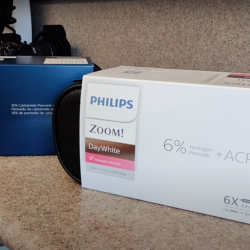Truths and Myths about Tooth Whitening
Posted on 16 August, 2022 by Hillsborough Dental

In response to many questions from patients and friends, along with misinformation and illegal activity which I see all too frequently, I’ve written this short blog to give a professional viewpoint on tooth whitening.
I have included a total of 15 myths and am interested to see how many you knew to be true and how many you were unaware of.
Laser whitening
The concept of 'Laser whitening' has become popular among the public as it sounds like you are getting more than just 'normal' whitening.
Everyone knows lasers are cool, so laser whitening must be better - right?
Well actually no, this is a common myth on a couple of issues.
The first myth is the name is very misleading - there is no use of a laser whatsoever - so it could probably be taken up under violation of trades description. Actually what the treatment uses is an intense LED or halogen light which is usually blue in colour.
The second myth is that it is better than non-'laser' treatment. All the light does is provide heat to accelerate the action of the gel bleach. So it shaves maybe 15 minutes off the treatment, but doesn't give a better result. It has the downside of sometimes overheating your lips or even the nerves in your teeth making them sensitive.
The third myth of 'laser whitening' is that it works better than professional home tray whitening - not true. It gives a quite dramatic immediate effect, but much of this is due to dehydration of the teeth. They are normally in a moist, saliva environment, protected from the elements by lips, but during treatment your teeth are exposed for around an hour using lip retractors to keep the gel off your lips and gums. Your tooth colour darkens or 'settles' a bit within 24-48 hours after 'laser whitening' as teeth rehydrate to their true colour - still brighter than pre-treatment, but not as dramatic as immediately post-treatment.
Myth four of 'laser whitening' is it must be the best because it is the most expensive - wrong - it is the most expensive simply because it takes up more time in the dental chair than other whitening treatments.
Whitening toothpastes
Companies selling whitening toothpastes use great marketing promoting the advantages of bright smiles, but there are some significant myths surrounding them.
The first is that your teeth will look as white as the model's teeth. This may not be the case as people's teeth colour varies and your natural colour may be darker.
The second myth is that using a whitening toothpaste will get the same results as paying a dentist for professional whitening. It can't achieve this - the concentration of the whitening element of professional whitening treatments (hydrogen peroxide) is at least 60 times that of a whitening toothpaste. The peroxide in toothpaste is not of high enough concentration nor is it applied for long enough to penetrate through the enamel to the dentine which is where the colour comes from in a tooth. All it can do is affect surface stains on your teeth like tea or coffee.
A third myth about whitening toothpastes is that they work by bleaching your teeth. As previously noted this effect is very limited because of low peroxide concentrations. The main action of such toothpastes is a polishing action - they are full of abrasives which help to polish surface stains off your teeth. Smokers toothpastes are even more abrasive to try and remove stubborn tobacco stains.
The last myth is that if used for long enough, whitening toothpastes will eventually whiten your teeth. Alarmingly, this is actually the opposite of what can happen. The enamel of your teeth (the outer layer) is transparent like glass and has very little colour, but the thicker it is, the less the inner dentine layer shows through which is where your tooth colour comes from. So if you abrade the enamel over a prolonged time, it becomes thinner and therefore the dentine shows through more and your teeth look darker. I've seen this happening in my own practice and I don't blame the patients - I blame marketers.
Strips and pre-fills
There are cheaper whitening alternatives like whitening strips and pre-filled single-use whitening trays.
I suppose the myth with these is that they are as good as professional tray whitening. They are very good indeed, especially for the price, but they are not as good because whilst they maintain the whitening gel in close contact with your teeth, they fail to seal out saliva. Saliva is great at inactivating the peroxide and reducing its effect.
Myth two is that all professional trays are the same - definitely not. They are made of different grades and thicknesses of usually EVA plastic. They need to be as stiff and close fitting as possible so they don't flex too much when you chew on them, because this would allow saliva in. We use a particular technique in the manufacture of our trays to 'super seal' them so that your gel is active for as long as possible up to the prescribed application time.
It may also be considered a myth that these are actually a cheaper treatment in the long term because you will need more of them to achieve the same result as professional trays, but also because when you want to top-up the whitening effect maybe 12 months down the line, you need to buy new strips or pre-filled trays, whereas with professional trays you just need a small amount of fresh gel which you can then use in your already existing custom-fit trays. Therefore pre-fills work out more expensive.
Beautician Treatment
The biggest myth about beautician or 'trained tooth whitening technician' treatment is that this is legal - it is not legal. The only persons legally allowed to whiten your teeth in the UK are dentists or dental hygienists or dental therapists who are on the General Dental Council (GDC) register. The reason for this is mainly because peroxide gels burn soft tissues like gums, cheeks, lips, eyes. Also the wrong concentration of gel applied for too long causes permanent sensitivity or even nerve death (requiring root canal) in teeth.
A second myth would be that beauticians are regulated for tooth whitening and standards of hygiene. This is not the case. There will be no standards of sterilisation of equipment and instruments used in your mouth.
Myth three - if something goes wrong during treatment by a beautician or any other person other than a legally allowed dental professional, the whitening company will have insurance and compensate you. Wrong - they are breaking the law so no insurance company will indemnify them.
I've seen patients with burns and I've got a patient who did a cheap shopping mall whitening and has permanently sensitive teeth now and sadly there is little I can do to fix this. Why take the risk, it just doesn't make sense.
Internet sourced whitening products
The internet has become such an amazing source of products in every conceivable area of interest a consumer could have, and tooth whitening has not remained outside this market.
However, the myth here is that what you think you are buying is actually what you are buying. Fake product is everywhere and whitening gels are no exception. The problem is you have no idea what is in the fake product. It may have a very low concentration of peroxide or more dangerously, a very high concentration (such as was revealed on a Watchdog TV investigation) placing you at high risk of chemical burns.
There also appear to be branded products like pre-filled trays from major dental companies, but again these are either fake or illegal imports. Legislation for concentrations vary between countries, but dental manufacturers and dental professionals have to work within the law, so they will not supply imported product to the UK market and will not sell directly to the public because this is not legal. The only place you are sure of genuine, safe, reliable and legal products is from dental practices.
I hope you have good success and an attractive result whenever you get your own teeth whitened.
Like I say “One of the greatest assets to your beauty is confidence, and the confidence that a nice smile can give you is invaluable.”
If you are not happy with your smile, teeth whitening is a great first step.
New Blog Posts

Truths and Myths about Tooth Whitening
16 August, 2022





